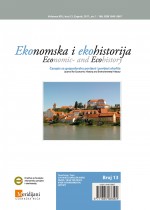CLIMATE CHANGE IN THE EASTERN ALPS AND THE FLOOD PATTERN OF THE DRAVA RIVER
CLIMATE CHANGE IN THE EASTERN ALPS AND THE FLOOD PATTERN OF THE DRAVA RIVER
Author(s): Dénes Lóczy, József Dezső, Péter GyenizseSubject(s): Geography, Regional studies, Energy and Environmental Studies, Physical Geopgraphy, Environmental Geography
Published by: Društvo za hrvatsku ekonomsku povijest i ekohistoriju - Izdavačka kuća Meridijani
Keywords: climate change; precipitation; floods; Drava; Mura;
Summary/Abstract: A remarkable temperature rise (above the world average of 0.2°C per decade) is predicted for the Alpine section of the Drava catchment with higher likelihood than changes in the amount and annual regime of precipitation. Monthly precipitation data show increasing values in the northeast and characteristic dropping trends in southern part of the basin, with growing drought hazard. A simple correlation between long-term precipitation (daily, weekly and monthly values) and Drava discharge cannot be found from meteorological records. A possible explanation is that runoff generation also depends on the form of precipitation, water saturation of soils and vegetation cover. Since these factors are all related to climate change, the paper investigates whether the annual pattern of floods on the Drava River depends more closely on snow melt or on the duration and amount of rainfall. As opposed to snow depth and days with snow cover, soil saturation in summer shows an increase in the upper catchment. While large-scale spring melt is gradually shifting to earlier dates, early spring high water levels do not reach flood levels. It is investigated how the distribution of precipitation along the upper Drava and upper Mura control flood response in the lower Drava catchment.
Journal: Ekonomska i ekohistorija - Časopis za gospodarsku povijest i povijest okoliša
- Issue Year: 2017
- Issue No: 13
- Page Range: 5-13
- Page Count: 9
- Language: English

